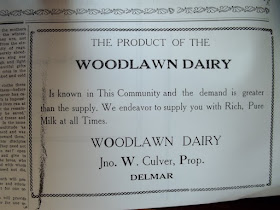For those who may do family tree research I have copied the 1917 phone directory over for Delmar. Altho Delmar Delaware is listed on all addresses you can tell, where street addresses are given, Delmar Maryland is included. I have never had any luck putting columns in Blogger so allow for the sloppy columns.
BELL TELEPHONE DIRECTORY JANUARY 20, 1917
DELMAR DEL.
54-5 Adkins, J G, r…………………………….nr Delmar
51-2 Adkins R W, genl mdse……………………….State
4-2 Bank of Delmar, bank………………………...Delmar
54-14 Bradley G H, r …………………………...nr Delmar
22-11 Brayshaw Dr. J, Physician ……………….Delmar
22-2 Brayshaw Dr, J, r ………………………….Delmar
50-2 Brewington A, Autos & Supplier State Delmar Del
32 Citizens Gas Co, Office …………….Railroad Ave
41-13 Culver Irving, “The Orchards” …….nr Delmar Del
29 Culver Irving…………………….Fruit Commissioner
35 Culver Irving ……………………………...Residence
36-3 Culver J Willims, genl Mdse………………...N 2nd
7 Culver J W …………………………………..Residence
48-2 Culver M W , genl Mdse…………...Pine Delmar Del
5-2 Culver S. N., Clothier & Furnisher ……….Delmar Del
59 Culver T S , r……………………………….…Elizabeth
21 Delmar Ice Co, Ice Factory………………….Delmar Del
17-11 Delmar Packing Co, Cannery…………….Delmar Del
19 Del Produce Ex, Inc S M Yingling Agt office Delmar Del
15 Delmar Union Store Co …………………Genl Mdse
8 Ellegood Dr Robt ……………………………...Office
14 Elliott F G……………………………….…Hardware
17-2 Elliott J J, Lumber Factory…………….Delmar Del
51-4 Elliott J J, r…………….cor Maple & Highland Av
42-5 Evans Ernest, r…………………..……..near Melson
10 Faulkner F N, r………………….…..State Delmar Del
25 First National Bank……………………………….….
46 Francis Elder A B, r…………………….…Delmar Del
12 Frazier Jos…………………………………...Residence
24 Freeney J W ………………………………….Residence
43-2 Freeney Miss Rosa L, r………………………..Delmar
43-11 Freeny E E, r…………………………….Delmar Del
16 German & Co, M H…………………………..Dry goods
53-3 Gordy O L Hardware & grocs………………….…State
53-3 Gordy & Holloway, mfrs Cement Blocks………..State
2 Haddock S B, r…………………………………….Delmar
44 Hastings G L ……………………………………….N 2d
3 Hastings & Co …………………...Groceries & Dry Goods
11 Hastings & Co, G L…………………………Wood dealer
9-2 Hearn Albert H, groceries……………………….Delmar
51-11 Hearn Geo E, r……………………...State Delmar Del
54-23 Hearn Geo W, r……………………………..nr Delmar
53-2 Hearn Jos W, r………………………..East Delmar Del
40 Hickey H T…………………………………...Residence
4-11 Holloway Jas, r………………………………...Delmar
28-2 James H B, office………………………..Railroad Ave
26 James H B ………………………………..…Residence
23-3 Jones Geo T, Printing Office………….E Delmar Del
47 Krause S F, r……………………………………….N 2d
56 Long G L, r………………………...Chesnut Delmar Del
13-2 Lowe H S, Farm…………………RD No 3 Delmar Del
42-3 Lowe I S, r…………………………………..nr Delmar
27 Lowe L B …………………………………..…Residence
31 Lynch F E ……………………………………..Residence
36-11 Lynch Dr. Howard, Office…………….……….Delmar
36-2 Lynch Dr. Howard, r…………………………….Delmar
55-2 Marvel Wm S Sr, r……………………Grove Delmar Del
23-4 Melson E J, fancy groceries…………..East Delmar Del
54-31 Mills R J, r…………………………………nr Hebron
54-22 Mills W D, r…………………………………nr Delmar
41-2 Mitchell James W, r…………………………..nr Delmar
42-2 Moore L H, r………………………………….nr Delmar
42-23 Morris J P, r………………………………….nr Delmar
37 P B & W R R co……………………………….Pay station
58 Palm Charles A,r………………………………Delmar Del
23-2 Parker A L Groceries…………….Elizabeth Delmar Del
9-3 Parker Harry L, r…………………..…………..nr Delmar
41-32 Pennewell J J, r…………………..…..……..nr Delmar
1 Salisbury Brick Co, Inc, Brick yard….………………N 2d
30 Slemons S K…………………………………….Residence
49 Stephens W B, r………………..4th & Chesnut Delmar Del
51-3 Sturgis A J, groceries………………..E State Delmar Del
23-11 Sturgis T A, r …………………………………..Delmar
41-11 Tingle Zeno, r ………………………………..nr Delmar
57 Truitt W C, t……………………………….East Delmar Del
34 Veasey Mary Augusta…………………..Stone House, State
38-2 Wainwright M H, Bakery & Fancy Grocs….Railroad Av
48-11 Wainwright M H, r …………….2d & Pine, Delmar Del
6-11 Waller S B, r……………..…………………….…Delmar
54-3 Waller W J,r……………………………………nr Delmar
54-11 Weatherly L B, r………………………………nr Hebron
45 Wells J F, r…………………..….Chesnut & 4th Delmar Del
39 West Nathan,r…………………….………………...Delmar
33 Whayland S H…………………………………..Drug store
17-4 Whayland S H,r…………………………….………Jewel
6-2 Whayland W W, Groceries………………………..Delmar
42-13 White C H …………………………………..Residence
20 Wilson Jas T……………………………………...Clothing














































